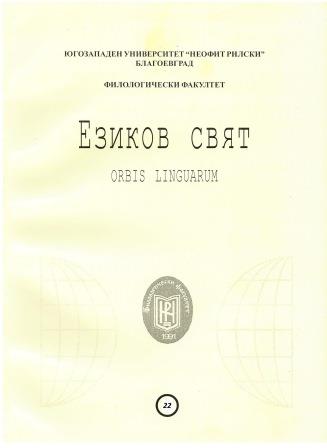SPECIFICS OF VERBAL VALENCE IN TERMS OF ITS PERCEPTION BY SPEAKERS (PSYCHOLINGUISTIC EXPERIMENT)
SPECIFICS OF VERBAL VALENCE IN TERMS OF ITS PERCEPTION BY SPEAKERS (PSYCHOLINGUISTIC EXPERIMENT)
Author(s): Olesia SulymaSubject(s): Language and Literature Studies, Theoretical Linguistics, Applied Linguistics, Morphology, Psycholinguistics
Published by: ЮГОЗАПАДЕН УНИВЕРСИТЕТ »НЕОФИТ РИЛСКИ«
Keywords: speech generation; valence; actionality; processuality; actant; adjunct; distributor
Summary/Abstract: The article provides an in-depth study of the valence of verbal vocabulary in terms of selection of positions that are open to distributors. The purpose of the article is to outline the specifics of valence of actional and processual verbs in and out of context, to establish the minimum and maximum number of open verb positions in different contexts through a targeted associative experiment. The object of analysis are the verbs of actional and processual semantics, which appear in personal and impersonal meanings or combine these properties: вирувати (to eddy), заливати (to flood), зацвітати (to bloom), икати (to hiccup), казати (to say), клекотіти (to roar), котитися (to roll), переконувати (to persuade), ревіти (to howl), розливатися (to spill), свистіти (to whistle), сніжити (to snow), чавкати (to smack). It has been established that verbs of processual semantics require more dependent components, and this trend is observed with verbs that have lost their actional seme and moved to the class of processual ones. A small number of open valence positions has been established, which corresponds to the traditional scientific division, in particular, of the verb світати (to dawn), but most reactions suggest the presence of an additional number of distributors compared to the scientific division by valence characteristics. Verbs that scientists mainly classify as monovalent with a wide potential for transformation into divalent, respondents ranked as divalent or trivalent, which makes it possible to finally change the traditional division of verbs into groups based on valence features. A small number of the identified open fourth position of verb lexemes indicates the inconsistency of its allocation for direct communication.
Journal: Езиков свят - Orbis Linguarum
- Issue Year: 22/2024
- Issue No: 1
- Page Range: 061-069
- Page Count: 9
- Language: English

